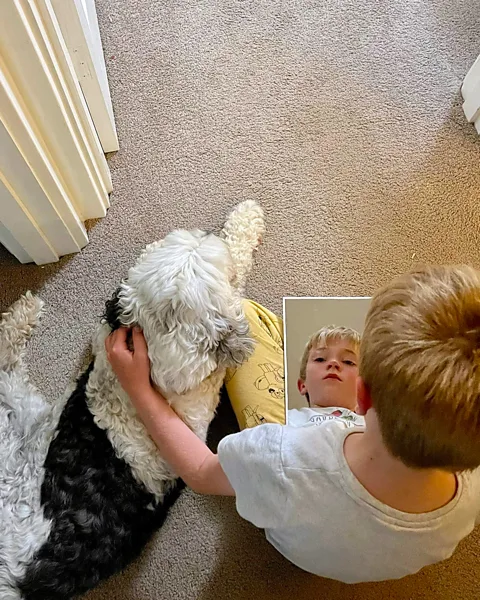
Alice in Wonderland syndrome is named after the character dreamed up by author Lewis Carroll, who may have also suffered from the condition (Credit: Getty Images)
Nine-year-old Josh Firth was in the car with his parents when he noticed something strange happening to the buildings on either side – they seemed to be getting bigger. When he told his mother, Sonja, she was baffled. As far as she was concerned, the buildings looked the same as they always had. "As the car was moving, the buildings on either side suddenly became enlarged and felt as if they were closing down on him," says Sonja.
It wasn't the only time this would happen. After returning from school one day, Josh, who is from Canberra, Australia, told his mother how "his teachers' faces became bigger, out of proportion to their bodies and the walls of the schoolroom got elongated and further away from him". Josh says that on one occasion when playing chess at school, he noticed "his fingers getting wider and bigger to the point of feeling unable to pick up the chess pieces".
These bizarre episodes were most frightening at night, when "the edges of his room were changing, the walls becoming wonky and closing down on him", leading to night terrors, according to Sonja. She says that, at times, her son would say her voice sounds different and he experiences her speech at a "lower pitch and a slower rate".
It took nearly two years for the family to find out what was going on. Josh suffers from a rare disorder known as Alice In Wonderland syndrome, sometimes also called Todd's syndrome.
Despite being formally described by doctors as a distinct syndrome in 1955 and some symptoms being recorded by doctors even earlier than this, the exact causes of Alice in Wonderland syndrome still remain shrouded in a mystery that Alice herself might have found curiouser and curiouser.
As researchers attempt to unravel this strange condition, they hope it could provide vital insights into how our brains interpret the world around us.

Whenever Josh now carries a mirror with him for whenever he needs a "reality check" when he starts to experience symptoms (Credit: Sonja Firth)
Thanks to the signals from our assorted senses, which combine with our past life experiences, each of us perceives the world differently to one another. We all exist in our own unique reality. "Perception is not a passive process of merely seeing, hearing, feeling, tasting or smelling," says Moheb Costandi, a London-based neuroscientist and writer who discusses Alice in Wonderland syndrome in his book Body Am I. "It is an active process. The brain acts upon incoming sensory stimuli, based on our past experiences and biases. The way we perceive things influences how we act, and how we act influences what we perceive."
But, at times our perception can become disordered, such as when people suffer from hallucinations, illusions or distortions. When the perception of ourselves and the world we live in is distorted, we risk losing our sense of self and suffer from depersonalisation. We might even end up experiencing the world itself as being unreal, a process known as derealisation.
In the past, Alice in Wonderland syndrome has been commonly dismissed as a largely harmless condition that doesn't require medical intervention. Some degree of symptoms are reported in the general population, with up to 30% of adolescents reporting mild or transient experiences of the syndrome. Certain cough medicines and illicit hallucinogenic substances are also known to trigger it.
Sometimes, however, changes in our perception of the world are triggered by something else underlying them. A wide range of causes have been suggested for Alice in Wonderland syndrome in both children and adults, including strokes, brain tumours, aneurysms, viral infections, epilepsy, migraines, eye diseases and psychiatric disorders such as depression and schizophrenia. It has also been associated with some infections such as Lyme disease, H1N1 influenza and Coxsackievirus B1. One study even identified it as a manifestation of Creutzfeldt-Jacob Disease (CJD), a fast-developing and often fatal neurodegenerative disorder.
Jan Dirk Blom, a professor of clinical psychopathology at Leiden University in the Netherlands, who is one of the few researchers who has dedicated himself to studying Alice in Wonderland syndrome, emphasises the need for doctors to take patients describing these symptoms seriously.
Blom says that diagnosis and recognition of Alice in Wonderland syndrome has barely improved over the past few decades. "That is a real challenge," he says. This often means it can be missed in patients for years.
“When I was a teenager, I became aware my limbs were huge, with my arms being absolutely massive” – Gillian Harris
Gillian Harris, from Pulborough, West Sussex, in England, was only diagnosed with Alice in Wonderland Syndrome six years ago at the age of 48, despite suffering with it from a young age. "As a child, at times, I felt as if things were further away from me and when I was a teenager, I also became aware my limbs were huge, with my arms being absolutely massive," she says. From the age of about 16, she was diagnosed and treated for epilepsy.
What little research does exist, however, is starting to provide some clues about why Alice in Wonderland syndrome afflicts some patients but not others.
"Genetics may perhaps play a role in creating a susceptibility for Alice in Wonderland syndrome in some people, although that is in need of empirical corroboration," says Blom.
In children, encephalitis caused mostly by Epstein-Barr virus is the most common cause of Alice in Wonderland syndrome, whilst it is most often associated with migraines among adults.
Brain imaging is also offering some insights too. These suggest that Alice in Wonderland syndrome may be caused by a dysfunction of a region of the brain called the temporo-parietal-occipital junction, where visual and spatial information are combined with signals about touch, body position and pain. Changes in this key meeting point of sensory information caused by lesions, neurological damage or swelling may alter how the brain interprets the signals.
There is still a lot of work that needs to be done to understand exactly what is going on in the brains of patients with Alice in Wonderland syndrome, says Blom. But he believes that the condition, which is known as AIWS for short, could provide vital clues about how the brain itself compiles information about our world.
"I think AIWS can teach us how much more intricate, complex, and yet balanced the whole process of perception is, as opposed to what we usually take for granted," says Blom. "Sometimes perception is hardly affected when even fairly large parts of the brain are compromised or even missing (as in prosopometamorphopsia due to gunshot wounds, which tends to disappear within weeks) whereas in other cases a dysfunctioning of minute stacks of nerve cells in [AIWS] may cause gross and lasting alterations to our perception. This syndrome teaches us that the whole network for (visual) perception has enormous parts that can be circumvented, or compensated for by other parts, whereas others appear to be absolutely crucial if we want to be able to properly perceive very basic aspects such as faces, lines, colours, and movement."

Symptoms of Alice in Wonderland syndrome are surprisingly common within the general population (Credit: Alamy)
But conducting brain studies that get to the root of what is going on in patients with Alice in Wonderland syndrome are not easy. "I think the big obstacle is the rarity of AIWS, and the fact that symptoms are fleeting," says Costandi. "And so it's difficult to scan a patient's brain while they're experiencing these symptoms."
But while in some cases the sensory distortions that come with Alice in Wonderland syndrome can be mildly disorientating, they can also be downright terrifying and can even pose a risk to those who suffer them at times. As Gillian, now 54, herself describes it: "When the symptoms were happening a lot I did not want to go to a train station on my own, in case it happened on the platform or get on a bus on my own in case it happens; you lose your independence. It has an impact on everything."
In most cases, research suggests, cases of Alice in Wonderland syndrome tends to resolve over time, however sometimes symptoms might recur depending on the underlying cause.
Gillian is on the highest dose of two anti-epileptic medications, and she has not only been seizure-free, but also AIWS-free for two years. Josh, on the other hand is still experiencing symptoms of "Alice", as he calls his condition, but he has developed coping mechanisms for it.
"Looking outside the window, or looking in the mirror really helps him, when everything is going on, as he looks at his facial features and helps shorten his episode of Alice," says Sonja. Josh now carries a pocket mirror with him when he is not at home, just in case he needs "a reality check".